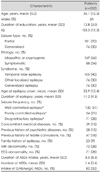1. Hendin H, Phillips MR, Vijayuakumar L, Pirkis J, Wang H, Yip P, et al. Epidemiology of suicide in Asia. 2008. Geneva, Switzerland: WHO Document Production Services;7–18.
2. Bark HM. The Trends and Patterns on Suicide in Korea. 2007. Seoul, Korea: Korean Institute of Criminology;93–130.
3. Pompili M, Girardi P, Ruberto A, Tatarelli R. Suicide in the epilepsies: a meta-analytic investigation of 29 cohorts. Epilepsy Behav. 2005. 7:305–310.

4. Christensen J, Vestergaard M, Mortensen PB, Sidenius P, Agerbo E. Epilepsy and risk of suicide: a population-based case-control study. Lancet Neurol. 2007. 6:693–698.

5. Tellez-Zenteno JF, Patten SB, Jetté N, Williams J, Wiebe S. Psychiatric comorbidity in epilepsy: a population-based analysis. Epilepsia. 2007. 48:2336–2344.

6. Jones JE, Hermann BP, Barry JJ, Gilliam FG, Kanner AM, Meador KJ. Rates and risk factors for suicide, suicidal ideation, and suicide attempts in chronic epilepsy. Epilepsy Behav. 2003. 4:Suppl 3. S31–S38.

7. Nilsson L, Ahlbom A, Farahmand BY, Asberg M, Tomson T. Risk factors for suicide in epilepsy: a case control study. Epilepsia. 2002. 43:644–651.

8. Mainio A, Alamäki K, Karvonen K, Hakko H, Särkioja T, Räsänen P. Depression and suicide in epileptic victims: a population-based study of suicide victims during the years 1988-2002 in northern Finland. Epilepsy Behav. 2007. 11:389–393.

9. Kalinin VV, Polyanskiy DA. Gender and suicidality prediction in epilepsy. Epilepsy Behav. 2005. 7:657–663.

10. Ritaccio A, Devinsky O. Ettinger AB, Kanner AM, editors. Personality disorders in epilepsy. Psychiatric issues in epilepsy: a practical guide to diagnose and treatment. 2007. 2nd ed. Philadelphia: Lippincott Williams and Wilkins;147–161.
11. Verrotti A, Cicconetti A, Scorrano B, De Berardis D, Cotellessa C, Chiarelli F, et al. Epilepsy and suicide: pathogenesis, risk factors, and prevention. Neuropsychiatr Dis Treat. 2008. 4:365–370.

12. Brown GK, Beck AT, Steer RA, Grisham JR. Risk factors for suicide in psychiatric outpatients: a 20-year prospective study. J Consult Clin Psychol. 2000. 68:371–377.

13. Mann JJ, Waternaux C, Haas GL, Malone KM. Toward a clinical model of suicidal behavior in psychiatric patients. Am J Psychiatry. 1999. 156:181–189.
14. Jacobs DG, Jamison KR, Baldessarini RJ, Fawcett JA, Hendin H, Gutheil TG. Suicide: clinical/risk management issues for the psychiatrist. CNS Spectrums. 2000. 5:32–54.
15. Jacobs DG, Brewer M, Klein-Benheim M. Jacobs DG, editor. Suicide assessment: an overview and recommended protocol. The Harvard Medical School guide to suicide assessment and intervention. 1999. San Francisco: Jossey-Bass;3–39.
16. Sheehan DV, Lecrubier Y, Sheehan KH, Amorim P, Janavs J, Weiller E, et al. The Mini-International Neuropsychiatric Interview (M.I.N.I.): the development and validation of a structured diagnostic psychiatric interview for DSM-IV and ICD-10. J Clin Psychiatry. 1998. 59:Suppl 20. S22–S33.
17. Beck AT, Ward CH, Mendelson M, Mock J, Erbaugh J. An inventory for measuring depression. Arch Gen Psychiatry. 1961. 4:561–571.

18. Beck AT, Kovacs M, Weissman A. Assessment of suicidal intention: the Scale for Suicidal Ideation. J Consult Clin Psychol. 1979. 47:343–352.
19. Kim ZS, Lee YS, Lee MS. Two-and four-subtest short forms of the Korean-Wechsler Adult Intelligence Scale. Seoul J Psychiatry. 1994. 19:121–126.
20. Rhee MK, Lee YH, Jung HY, Choi JH, Kim SH, Kim YK, et al. A standardization study of Beck Depression Inventory II - Korean Version (K-BDI): validity. Korean J Psychopathol. 1995. 4:96–104.
21. Yook SP, Kim ZS. A clinical study on the Korean version of Beck Anxiety Inventory: comparative study of patient and non-patient. Korean J Clin Psychol. 1997. 16:185–197.
22. Kim KI, Kim JH. The standardization study of Symptom Checklist-90-Revision in Korea III. Ment Health Res. 1984. 2:278–311.
23. Shin MS, Park KB, Oh KJ, Kim JS. A study of suicidal ideation among high school students : the structural relation among depression, hopelessness, and suicidal ideation. Korean J Clin Psychol. 1990. 9:1–19.
24. Miller JM, Kustra RP, Vuong A, Hammer AE, Messenheimer JA. Depressive symptoms in epilepsy: prevalence, impact, aetiology, biological correlates and effect of treatment with antiepileptic drugs. Drugs. 2008. 68:1493–1509.
25. Ketter TA, Post RM, Theodore WH. Positive and negative psychiatric effects of antiepileptic drugs in patients with seizure disorders. Neurology. 1999. 53:S53–S67.
26. Blumer D, Montouris G, Davies K, Wyler A, Phillips B, Hermann B. Suicide in epilepsy: psychopathology, pathogenesis, and prevention. Epilepsy Behav. 2002. 3:232–241.

27. Cramer JA, Blum D, Reed M, Fanning K. Epilepsy Impact Project Gruop. The influence of comorbid depression on seizure severity. Epilepsia. 2003. 44:1578–1584.

28. Brent DA, Crumrine PK, Varma RR, Allan M, AlIman C. Phenobarbital treatment and major depressive disorder in children with epilepsy. Pediatrics. 1987. 80:909–917.
29. U.S. Department of Health and Human Services. Food and Drug Administration. Center for Drug Evaluation and Research. Office of Translational Sciences. Office of Biostatistics. Statistical Review and Evaluation: Antiepileptic Drugs and Suicidality. 2008.
30. Hesdorffer DC, Kanner AM. The FDA alert on suicidality and antiepileptic drugs: fire or false alarm? Epilepsia. 2009. 50:978–986.

31. Kanner AM. Psychiatric issues in epilepsy: the complex relation of mood, anxiety disorders, and epilepsy. Epilepsy Behav. 2009. 15:83–87.

32. Zigmond AS, Snaith RP. The hospital anxiety and depression scale. Acta Psychiatr Scand. 1983. 67:361–370.

33. Gilliam FG, Barry JJ, Hermann BP, Meador KJ, Vahle V, Kanner AM. Rapid detection of major depression in epilepsy: a multicentre study. Lancet Neurol. 2006. 5:399–405.

34. Harris EC, Barraclough B. Suicide as an outcome for mental disorders. A meta-analysis. Br J Psychiatry. 1997. 170:205–228.
35. Grabowska-Grzyb A, Jedrzejczak J, Nagańska E, Fiszer U. Risk factors for depression in patients with epilepsy. Epilepsy Behav. 2006. 8:411–417.

36. Thompson AW, Miller JW, Katon W, Chaytor N, Ciechanowski P. Sociodemographic and clinical factors associated with depression in epilepsy. Epilepsy Behav. 2009. 14:655–660.





 PDF
PDF ePub
ePub Citation
Citation Print
Print








 XML Download
XML Download